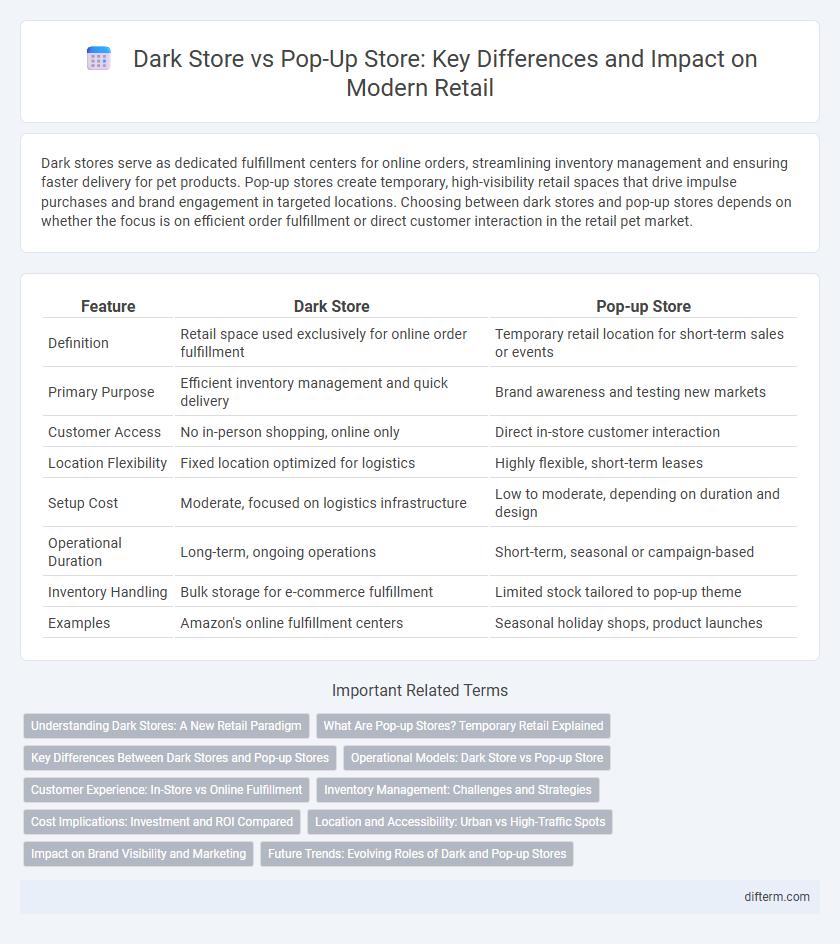Dark stores serve as dedicated fulfillment centers for online orders, streamlining inventory management and ensuring faster delivery for pet products. Pop-up stores create temporary, high-visibility retail spaces that drive impulse purchases and brand engagement in targeted locations. Choosing between dark stores and pop-up stores depends on whether the focus is on efficient order fulfillment or direct customer interaction in the retail pet market.
Table of Comparison
| Feature | Dark Store | Pop-up Store |
|---|---|---|
| Definition | Retail space used exclusively for online order fulfillment | Temporary retail location for short-term sales or events |
| Primary Purpose | Efficient inventory management and quick delivery | Brand awareness and testing new markets |
| Customer Access | No in-person shopping, online only | Direct in-store customer interaction |
| Location Flexibility | Fixed location optimized for logistics | Highly flexible, short-term leases |
| Setup Cost | Moderate, focused on logistics infrastructure | Low to moderate, depending on duration and design |
| Operational Duration | Long-term, ongoing operations | Short-term, seasonal or campaign-based |
| Inventory Handling | Bulk storage for e-commerce fulfillment | Limited stock tailored to pop-up theme |
| Examples | Amazon's online fulfillment centers | Seasonal holiday shops, product launches |
Understanding Dark Stores: A New Retail Paradigm
Dark stores are specialized retail facilities optimized exclusively for online order fulfillment, eliminating the need for customer foot traffic and enabling faster delivery times. These stores leverage advanced inventory management systems and strategic urban locations to meet growing e-commerce demand efficiently. By operating as micro-fulfillment centers, dark stores reduce last-mile delivery costs and increase order accuracy compared to traditional retail formats.
What Are Pop-up Stores? Temporary Retail Explained
Pop-up stores are temporary retail spaces designed to create unique shopping experiences and drive brand engagement in high-traffic areas. These short-term installations enable retailers to test new markets, launch limited-edition products, or capitalize on seasonal demand without the long-term commitment of permanent storefronts. Pop-up stores often leverage agility and localized marketing to attract consumers, contrasting with dark stores that primarily function as fulfillment centers for online orders without physical customer interaction.
Key Differences Between Dark Stores and Pop-up Stores
Dark stores operate as dedicated fulfillment centers for online orders without customer foot traffic, optimizing inventory management and delivery speed. Pop-up stores function as temporary physical retail spaces designed for brand exposure and limited-time sales events, often placed in high-traffic locations. The key differences lie in their operational purpose, customer interaction, and duration of presence in the market.
Operational Models: Dark Store vs Pop-up Store
Dark stores operate as dedicated fulfillment centers designed exclusively for online order processing, enabling efficient inventory management and rapid delivery within urban areas. Pop-up stores function as temporary retail spaces that capitalize on limited-time promotions or seasonal demand, offering flexibility in location and inventory tailored to specific marketing campaigns. The operational model of dark stores emphasizes scalability and automation, while pop-up stores prioritize agility and direct consumer engagement.
Customer Experience: In-Store vs Online Fulfillment
Dark stores enhance online fulfillment by streamlining inventory management and enabling faster delivery, improving overall customer satisfaction with quick and accurate order processing. Pop-up stores create engaging in-store experiences through temporary physical presence, allowing brands to interact directly with customers, boost brand awareness, and gather real-time feedback. Balancing dark stores' efficient online fulfillment with pop-up stores' experiential retail tactics drives superior customer experience across both digital and physical channels.
Inventory Management: Challenges and Strategies
Dark stores face significant inventory management challenges due to their exclusive online order fulfillment, requiring precise real-time stock tracking and rapid replenishment to meet delivery demands. Pop-up stores often struggle with limited storage space and unpredictable stock needs, necessitating flexible inventory strategies such as just-in-time delivery and dynamic assortment adjustments. Both formats benefit from integrating advanced inventory management systems and data analytics to optimize stock levels and reduce overstock or stockout scenarios.
Cost Implications: Investment and ROI Compared
Dark stores require significant initial investment in location leasing, technology integration, and inventory management systems, yet offer higher operational efficiency and scalability, leading to improved long-term ROI. Pop-up stores demand lower upfront costs and shorter commitment periods, making them ideal for testing new markets and seasonal products, but often yield less predictable returns and limited scalability. Evaluating cost implications involves balancing the substantial fixed costs and sustained revenue potential of dark stores against the agility and lower financial risk of pop-up stores in retail strategies.
Location and Accessibility: Urban vs High-Traffic Spots
Dark stores are strategically located in urban areas with easy access to delivery routes, optimizing rapid order fulfillment without customer in-store traffic. Pop-up stores are typically positioned in high-traffic spots such as shopping malls and busy streets, maximizing visibility and spontaneous consumer engagement. Urban dark stores focus on logistical efficiency, while pop-up stores prioritize accessibility and foot traffic for immediate sales impact.
Impact on Brand Visibility and Marketing
Dark stores enhance brand visibility by serving as efficient fulfillment centers that support fast delivery, indirectly boosting customer satisfaction and positive brand perception. Pop-up stores create immediate, physical brand awareness by engaging customers with immersive, localized experiences that generate buzz and social media sharing. Both formats drive marketing effectiveness by targeting different consumer touchpoints--dark stores optimize convenience and reliability, while pop-up stores amplify direct interaction and experiential branding.
Future Trends: Evolving Roles of Dark and Pop-up Stores
Dark stores and pop-up stores are increasingly shaping the future of retail by optimizing urban fulfillment and experiential marketing. Dark stores serve as mini-warehouses dedicated to rapid e-commerce delivery, reducing last-mile logistics costs and improving customer satisfaction with faster order fulfillment. Pop-up stores provide brands with flexible, low-investment opportunities to test markets, engage consumers in unique retail experiences, and adapt quickly to evolving trends and seasonal demands.
Dark store vs Pop-up store Infographic

 difterm.com
difterm.com